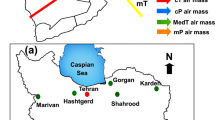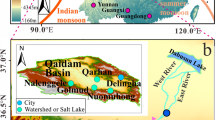Abstract
In the Qaidam Basin, a harsh environment limits precipitation observations, which hinders the understanding of the hydrological cycle. This study compared and discerned the applicability of 11 general circulation models (GCMs) simulating δ18O and δ2H in precipitation in the Qaidam basin and tracked the water vapor backward trajectory by the Hybrid Single-Particle Lagrangian Integrated Trajectory (HYSPLIT). The LDMZ (nudged) model is most applicable in the study area. The moisture sources are the Westerlies and inland recycled moisture. This study can improve the understanding of the adaptability of GCMs in the arid alpine zone and the hydrological cycle in the Tibetan Plateau.







Similar content being viewed by others
Data availability
All meteorological data used during this study are available from the China Meteorological Data Service Center at http://data.cma.cn/. Simulations of hydrogen and oxygen stable isotopes in precipitation used during this study can be downloaded from https://data.giss.nasa.gov/swing2/. Observations of hydrogen and oxygen stable isotopes in precipitation used during this study are available from Tibetan Network for Isotopes in Precipitation dataset as cited by Yao et al. (2013). GDAS1 data from NCEP/NCAR are available from National Oceanic and Atmospheric Administration at https://www.noaa.gov/.
References
Araguás-Araguás L, Froehlich K, Rozanski K (1998) Stable isotope composition of precipitation over southeast Asia. J Geophys Res Atmos 103:28721–28742. https://doi.org/10.1029/98JD02582
Gat JR, Bowser CJ, Kendall C (1994) The contribution of evaporation from the Great Lakes to the continental atmosphere: estimate based on stable isotope data. Geophys Res Lett 21:557–560. https://doi.org/10.1029/94GL00069
Yao T, Masson-Delmotte V, Gao J et al (2013) A review of climatic controls on δ18O in precipitation over the Tibetan Plateau: Observations and simulations. Rev Geophys 51:525–548. https://doi.org/10.1002/rog.20023
Tian L, Yao T, MacClune K et al (2007) Stable isotopic variations in west China: a consideration of moisture sources. J Geophys Res Atmos 112:1–12. https://doi.org/10.1029/2006JD007718
Tian L, Yao T, Numaguti A, Sun W (2001) Stable isotope variations in monsoon precipitation on the Tibetan Plateau. J Meteorol Soc Jpn 79:959–966
Clarke I, Fritz P (1997) Environmental isotope in hydrogeology. Springer-Verlag, Lewis Publishers
Craig H, Gordon LI (1965) Deuterium and oxygen 18 variations in the ocean and the marine atmosphere. In: Tongiorgi E (ed) Stable Isotopes in Oceanographic Studies and Paleotemperatures. Laboratorio di Geologia Nucleare, Pisa, pp 9–130
Dansgaard W (1964) Stable isotopes in precipitation. Tellus 16:436–468
Pang Z, Kong Y, Li J, Tian J (2017) An isotopic geoindicator in the hydrological cycle. Procedia Earth Planet Sci 17:534–537. https://doi.org/10.1016/j.proeps.2016.12.135
Putman AL, Fiorella RP, Bowen GJ, Cai Z (2019) A global perspective on local meteoric water lines: meta-analytic insight into fundamental controls and practical constraints. Water Resour Res 55:6896–6910. https://doi.org/10.1029/2019WR025181
Tian L, Yu W, Schuster PF et al (2020) Control of seasonal water vapor isotope variations at Lhasa, southern Tibetan Plateau. J Hydrol 580:124237. https://doi.org/10.1016/j.jhydrol.2019.124237
Cui BL, Li XY (2015) Stable isotopes reveal sources of precipitation in the Qinghai Lake Basin of the northeastern Tibetan Plateau. Sci Total Environ 527–528:26–37. https://doi.org/10.1016/j.scitotenv.2015.04.105
Guo X, Tian L, Wen R et al (2017) Controls of precipitation δ18O on the northwestern Tibetan Plateau: a case study at Ngari station. Atmos Res 189:141–151. https://doi.org/10.1016/J.ATMOSRES.2017.02.004
Rolph G, Stein A, Stunder B (2017) Real-time environmental applications and display sYstem: READY. Environ Model Softw 95:210–228. https://doi.org/10.1016/j.envsoft.2017.06.025
Stein AF, Draxler RR, Rolph GD et al (2015) Noaa’s hysplit atmospheric transport and dispersion modeling system. Bull Am Meteorol Soc 96:2059–2077. https://doi.org/10.1175/BAMS-D-14-00110.1
Guo X, Feng Q, Si J, Zhang X (2022) Considerable influences of recycled moistures and summer monsoons to local precipitation on the northeastern Tibetan Plateau. J Hydrol 605:127343. https://doi.org/10.1016/j.jhydrol.2021.127343
Kostrova SS, Meyer H, Fernandoy F et al (2020) Moisture origin and stable isotope characteristics of precipitation in southeast Siberia. Hydrol Process 34:51–67. https://doi.org/10.1002/hyp.13571
Gimeno L, Vazquez M, Eiras-Barca J et al (2020) Recent progress on the sources of continental precipitation as revealed by moisture transport analysis. Earth-Sci Rev 201:103070. https://doi.org/10.1016/j.earscirev.2019.103070
Xu B, Cao J, Hansen J et al (2009) Black soot and the survival of Tibetan glaciers. Proc Natl Acad Sci U S A 106:22114–22118. https://doi.org/10.1073/pnas.0910444106
Tian L, Yao T, Li Z et al (2006) Recent rapid warming trend revealed from the isotopic record in Muztagata ice core, eastern Pamirs. J Geophys Res. https://doi.org/10.1029/2005JD006249
Kuang X, Jiao JJ (2016) Review on climate change on the Tibetan plateau during the last half century. J Geophys Res 121:3979–4007. https://doi.org/10.1002/2015JD024728
Kang SC, Zhang YJ, Qin DH et al (2007) Recent temperature increase recorded in an ice core in the source region of Yangtze River. Chin Sci Bull 52:825–831. https://doi.org/10.1007/s11434-007-0140-1
Song C, Sheng Y, Zhan S et al (2020) Impact of amplified evaporation due to lake expansion on the water budget across the inner Tibetan Plateau. Int J Climatol 40:2091–2105. https://doi.org/10.1002/joc.6320
Chen Y, Li Z, Fan Y et al (2015) Progress and prospects of climate change impacts on hydrology in the arid region of northwest China. Environ Res 139:11–19. https://doi.org/10.1016/j.envres.2014.12.029
Fan C, Song C, Li W et al (2021) What drives the rapid water-level recovery of the largest lake (Qinghai Lake) of China over the past half century? J Hydrol 593:125921. https://doi.org/10.1016/j.jhydrol.2020.125921
Ma YJ, Li XY, Liu L et al (2018) Measurements and modeling of the water budget in semiarid high-altitude Qinghai Lake Basin, Northeast Qinghai-Tibet Plateau. J Geophys Res Atmos 123:10857–10871. https://doi.org/10.1029/2018JD028459
Javaux M, Rothfuss Y, Vanderborght J et al (2016) Isotopic composition of plant water sources. Nature 536:E1–E3. https://doi.org/10.1038/nature18946
Sprenger M, Tetzlaff D, Soulsby C (2017) Soil water stable isotopes reveal evaporation dynamics at the soil–plant–atmosphere interface of the critical zone. Hydrol Earth Syst Sci 21:3839–3858. https://doi.org/10.5194/hess-21-3839-2017
Che Y, Zhang M, Wang S et al (2016) Stable water isotopes of precipitation in China simulated by SWING2 models. Arab J Geosci 9:1–12. https://doi.org/10.1007/s12517-016-2755-5
Wang S, Zhang M, Chen F et al (2015) Comparison of GCM-simulated isotopic compositions of precipitation in arid central Asia. J Geogr Sci 25:771–783. https://doi.org/10.1007/s11442-015-1201-z
Joussaume S, Sadourny R, Jouzel J (1984) A general circulation model of water isotope cycles in the atmosphere. Nature 311:680
Kurita N, Noone D, Risi C et al (2011) Intraseasonal isotopic variation associated with the Madden-Julian Oscillation. J Geophys Res Atmos 116:1–20. https://doi.org/10.1029/2010JD015209
Lee JE, Fung I, DePaolo DJ, Henning CC (2007) Analysis of the global distribution of water isotopes using the NCAR atmospheric general circulation model. J Geophys Res Atmos 112:1–14. https://doi.org/10.1029/2006JD007657
Risi C, Bony S, Vimeux F, Jouzel J (2010) Water-stable isotopes in the LMDZ4 general circulation model: Model evaluation for present-day and past climates and applications to climatic interpretations of tropical isotopic records. J Geophys Res Atmos 115:1–27. https://doi.org/10.1029/2009JD013255
Schmidt GA, LeGrande AN, Hoffmann G (2007) Water isotope expressions of intrinsic and forced variability in a coupled ocean-atmosphere model. J Geophys Res Atmos 112:1–18. https://doi.org/10.1029/2006JD007781
Tindall JC, Valdes PJ, Sime LC (2009) Stable water isotopes in HadCM3: Isotopic signature of El Niño-Southern Oscillation and the tropical amount effect. J Geophys Res Atmos 114:1–12. https://doi.org/10.1029/2008JD010825
Yoshimura K, Kanamitsu M, Noone D, Oki T (2008) Historical isotope simulation using Reanalysis atmospheric data. J Geophys Res Atmos 113:1–15. https://doi.org/10.1029/2008JD010074
Cao L, Pan S (2014) Changes in precipitation extremes over the “Three-River Headwaters” region, hinterland of the Tibetan Plateau, during 1960–2012. Quat Int 321:105–115. https://doi.org/10.1016/j.quaint.2013.12.041
You Q, Kang S, Aguilar E, Yan Y (2008) Changes in daily climate extremes in the eastern and central Tibetan Plateau during 1961–2005. J Geophys Res Atmos 113:1–17. https://doi.org/10.1029/2007JD009389
Huang HL, Wang CC, Chen GTJ, Carbone RE (2010) The role of diurnal solenoidal circulation on propagating rainfall episodes near the eastern Tibetan Plateau. Mon Weather Rev 138:2975–2989. https://doi.org/10.1175/2010MWR3225.1
Wallace JM (1975) Diurnal variations in precipitation and thunderstorm frequency over the conterminous United States. Mon Weather Rev 103:406–419
Field RD, Jones DBA, Brown DP (2010) Effects of postcondensation exchange on the isotopic composition of water in the atmosphere. J Geophys Res Atmos. https://doi.org/10.1029/2010JD014334
Zhang X (2001) Spatial and temporal variations of stable isotopes in precipitation over the Tibetan Plateau and adjacent areas. Sci China (Series D) 31:353–361
Tian L, Masson-Delmotte V, Stievenard M et al (2001) Tibetan Plateau summer monsoon northward extent revealed by measurements of water stable isotopes. J Geophys Res Atmos 106:28081–28088. https://doi.org/10.1029/2001JD900186
Tian L, Yao T, Sun W et al (2001) Relationship between δ D and δ18O in precipitation on north and south of the Tibetan Plateau and moisture recyling. Sci China Ser D Earth Sci 44:789–796. https://doi.org/10.1007/BF02907091
An Z, Colman SM, Zhou W et al (2012) Interplay between the Westerlies and Asian monsoon recorded in Lake Qinghai sediments since 32 ka. Sci Rep 2:1–7. https://doi.org/10.1038/srep00619
Chen F, Wu D, Chen J et al (2016) Holocene moisture and East Asian summer monsoon evolution in the northeastern Tibetan Plateau recorded by Lake Qinghai and its environs: a review of conflicting proxies. Quat Sci Rev 154:111–129. https://doi.org/10.1016/j.quascirev.2016.10.021
Wu D, Zhou A, Zhang J et al (2020) Temperature-induced dry climate in basins in the northeastern Tibetan Plateau during the early to middle Holocene. Quat Sci Rev 237:106311. https://doi.org/10.1016/j.quascirev.2020.106311
Zhu JJ, Chen H, Gong GL (2015) Hydrogen and oxygen isotopic compositions of precipitation and its water vapor sources in eastern Qaidam basin. Environ Sci 36:2784–2790
Chen B, De XuX, Yang S, Zhang W (2012) On the origin and destination of atmospheric moisture and air mass over the Tibetan Plateau. Theor Appl Climatol 110:423–435. https://doi.org/10.1007/s00704-012-0641-y
Yao TD, Zhou H, Yang XX (2009) Indian monsoon influences altitude effect of δ18O in precipitation/river water on the Tibetan Plateau. Chin Sci Bull 54:2724–2731. https://doi.org/10.1007/s11434-009-0497-4
Guo D, Wang H (2012) The significant climate warming in the northern Tibetan Plateau and its possible causes. Int J Climatol 32:1775–1781. https://doi.org/10.1002/joc.2388
Yang K, Wu H, Qin J et al (2014) Recent climate changes over the Tibetan Plateau and their impacts on energy and water cycle: A review. Glob Planet Change 112:79–91. https://doi.org/10.1016/j.gloplacha.2013.12.001
Barnett TP, Pierce DW, Bonfils C (2008) Human-induced changes in the hydrology of the western United States. Science (80-) 319:1080–1083
Cui X, Graf HF (2009) Recent land cover changes on the Tibetan Plateau: a review. Clim Change 94:47–61. https://doi.org/10.1007/s10584-009-9556-8
Yang M, Nelson FE, Shiklomanov NI et al (2010) Permafrost degradation and its environmental effects on the Tibetan Plateau: A review of recent research. Earth-Science Rev 103:31–44. https://doi.org/10.1016/j.earscirev.2010.07.002
Funding
This work was funded by the National Natural Science Foundation of China (Grant/Award Number: 517037511 and 42101021).
Author information
Authors and Affiliations
Contributions
Conceptualization, XZ and TW; methodology and analysis, XZ, TW, FM, and LH; writing-original draft preparation, XZ; writing-review and editing, JC, JC, and TW; supervision, JC. All authors have read and agreed to the published version of the manuscript.
Corresponding author
Ethics declarations
Conflict of interest
The authors declare that they have no known competing financial interests or personal relationships that could have appeared to influence the work reported in this paper.
Additional information
Publisher's Note
Springer Nature remains neutral with regard to jurisdictional claims in published maps and institutional affiliations.
Supplementary Information
Below is the link to the electronic supplementary material.
Rights and permissions
Springer Nature or its licensor (e.g. a society or other partner) holds exclusive rights to this article under a publishing agreement with the author(s) or other rightsholder(s); author self-archiving of the accepted manuscript version of this article is solely governed by the terms of such publishing agreement and applicable law.
About this article
Cite this article
Zhang, X., Chen, J., Chen, J. et al. Simulating precipitation stable isotopes and tracking moisture sources in Qaidam Basin combining GCMs and HYSPLIT. J Radioanal Nucl Chem 332, 4877–4888 (2023). https://doi.org/10.1007/s10967-023-09180-0
Received:
Accepted:
Published:
Issue Date:
DOI: https://doi.org/10.1007/s10967-023-09180-0




